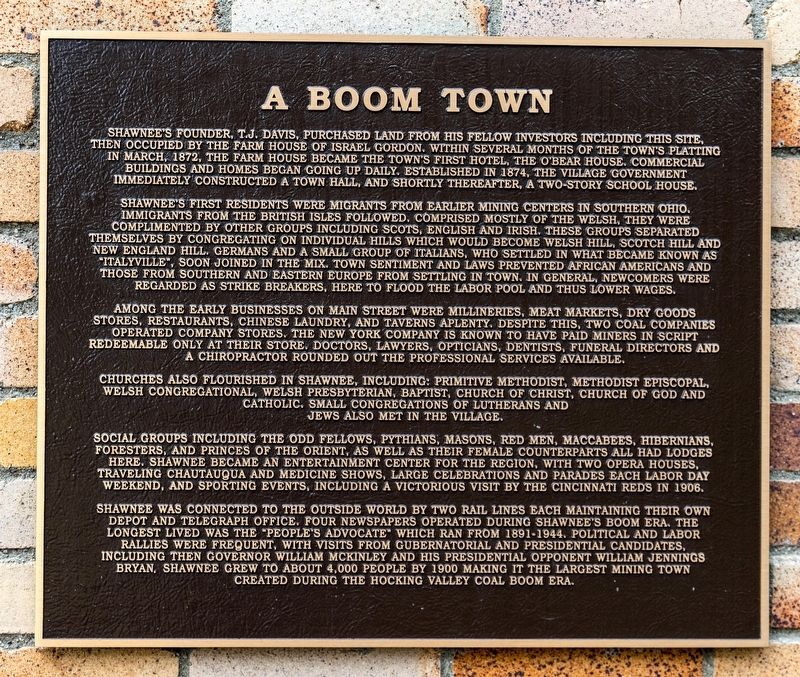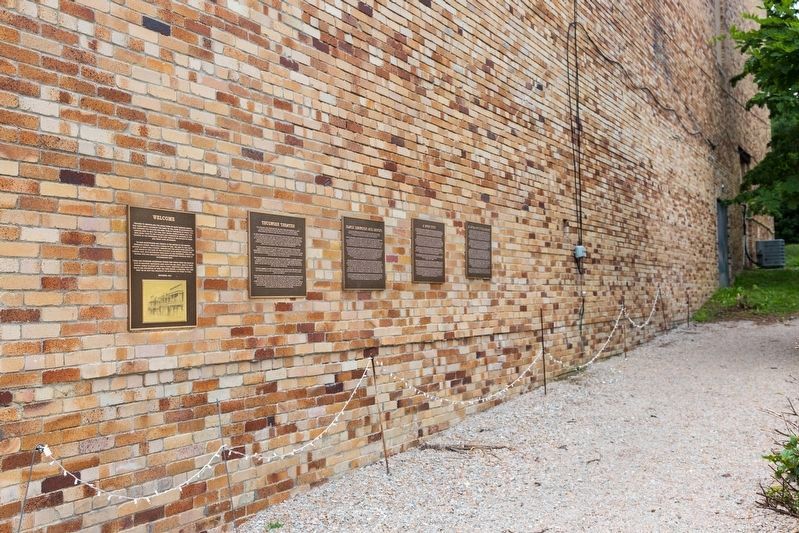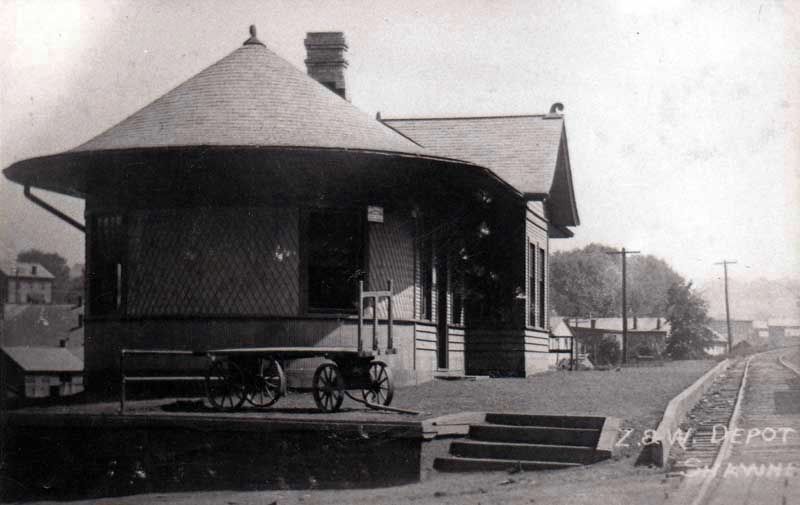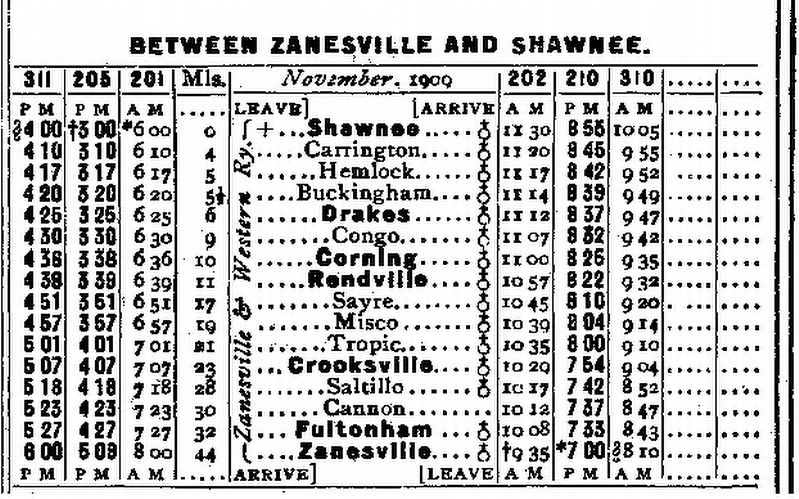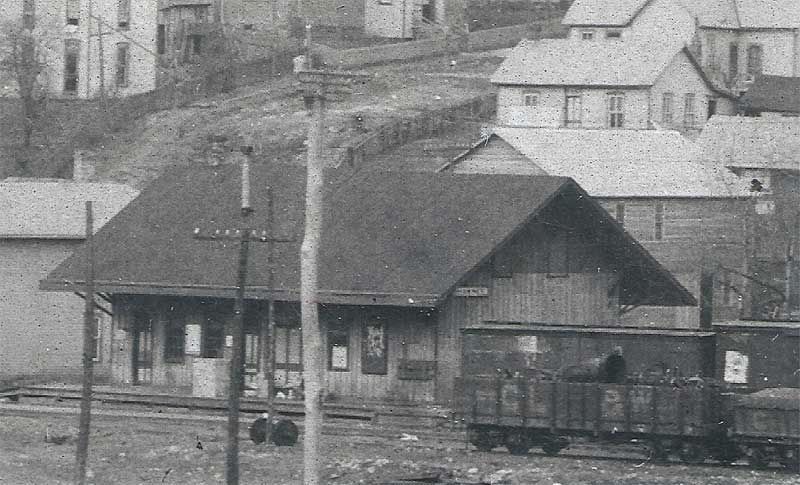Shawnee in Perry County, Ohio — The American Midwest (Great Lakes)
A Boom Town
Shawnee’s first residents were migrants from earlier mining centers in southern Ohio. Immigrants from the British Isles followed, comprising of mostly the Welsh, they were complemented by other groups including Scots, English and Irish. These groups separated themselves go congregating on individual hills which would become Welsh Hill, Scotch Hill, and New England Hill. Germans and a small group of Italians, who settled in what became known as “Italyville,” soon joined the mix. Town sentiment and laws prevented African Americans and those from southern and eastern Europe from settling in town. In general, newcomers were regarded as strike breakers, here to flood the labor pool and thus lower wages.
Among the early businesses on Main Street were milliners, meat markets, dry goods stores, restaurants, Chinese laundry, and taverns aplenty. Despite this, two coal companies operated company stores. The New York Company is known to h ave paid miners in scrip redeemable only at their store. Doctors, lawyers, opticians, dentists, funeral directors and a chiropractor rounded out the professional services available.
Churches also flourished in Shawnee, including: Primitive Methodist, Methodist Episcopal, Welsh Congregational, Welsh Presbyterian, Baptist, Church of Christ, Church of God and Catholic. Small congregations of Lutherans and Jews also met in the village.
Social groups including the Odd Fellows, Pythians, Masons, Red Men, Maccabees, Hibernians, Foresters and Princes of the Orient; as well as their female counterparts all had lodges here. Shawnee became an entertainment center for the region with two opera houses, traveling Chautauqua and medicine shows, large celebrations and parades each Labor Day weekend, and sporting events, including a victorious visit by the Cincinnati Reds in 1906.
Shawnee was connected to the outside world by two rail lines each maintaining their own depot and telegraph office. Four newspapers operated during Shawnee’s boom era. The longest lived was the People’s Advocate which ran from 1891-1944. Political and labor rallies were frequent, with visits from gubernatorial and presidential candidates, including then Governor William McKinley and his presidential opponent William
Jennings Bryan. Shawnee grew to about 4,000 people by 1900 making it the largest mining town created during the Hocking Valley coal boom era.
Erected 2011. (Marker Number 4.)
Topics and series. This historical marker is listed in these topic lists: Churches & Religion • Industry & Commerce • Railroads & Streetcars • Settlements & Settlers. In addition, it is included in the Former U.S. Presidents: #25 William McKinley series list. A significant historical year for this entry is 1874.
Location. 39° 36.24′ N, 82° 12.734′ W. Marker is in Shawnee, Ohio, in Perry County. Marker is on Main Street west of 2nd Street, on the right when traveling west. Touch for map. Marker is in this post office area: Shawnee OH 43782, United States of America. Touch for directions.
Other nearby markers. At least 8 other markers are within 2 miles of this marker, measured as the crow flies. Welcome to Shawnee and the Little Cities of Back Diamond Region (here, next to this marker); Black Diamonds and Bricks (here, next to this marker); Tecumseh Theater (here, next to this marker); Shawnee (a few steps from this marker); A Little City in the Forest (a few steps from this marker); Knights of Labor Opera House (within shouting distance of this marker); Saltlick Township Memorial Park (within shouting distance of this marker); World’s Greatest Mine Fire (approx. 1.3 miles away). Touch for a list and map of all markers in Shawnee.
Additional commentary.
1. Railroad Travel Options in Shawnee in 1909
At the beginning of the 20th century, if you wanted to travel any distance your choice was horse-and-buggy, or rail. Rural roads were poor to non-existent and would destroy the few primitive automobiles of that time if you made them go faster than a horse could walk.
In 1909 Shawnee was the last passenger station for two railway branch lines, one on the Zanesville and Western Railway and the other on the Baltimore and Ohio Railroad. The Z&W line ran to Zanesville and the B&O line ran to Newark, Ohio. Three trains ran in each direction every day between Shawnee and Newark. Two in each direction ran between Shawnee and Zanesville, for a total of five arrivals and five departures.
You could board a train to start a journey to practically anywhere in North America at 6:00 or 9:40 in the morning or at 3:00, 4:00, or 4:25 in the afternoon. It was a leisurely ride on these branch lines. Both were 44 miles long and if you rode to the end of the line it would take
you about two hours to get there.
On the Z&W you could change to a long distance train 36 minutes later at Corning, where Toledo & Ohio Central long-distance trains could take you to Columbus, Toledo and Chicago in one direction or to Marietta and Charleston West Virginia in the other. Or at Zanesville, you could change there for trains to Cleveland.
On the B&O, you had more choices. Frequent long-distance trains stopping at Newark could take you to Columbus, Chicago, St. Louis and points west, or east to Pittsburgh, Washington and New York. And in many of those cities you could change again to other long-distance trains going to points anywhere in the country.
So there were many options available to you if you wanted to travel from Shawnee, but it was not cheap. A one-way ticket from Shawnee to Chicago was $8 in 1909. That is the equivalent of over $200 today.
— Submitted September 8, 2019, by J. J. Prats of Powell, Ohio.
Credits. This page was last revised on September 24, 2019. It was originally submitted on September 8, 2019, by J. J. Prats of Powell, Ohio. This page has been viewed 372 times since then and 51 times this year. Photos: 1, 2, 3, 4, 5, 6. submitted on September 8, 2019, by J. J. Prats of Powell, Ohio.
